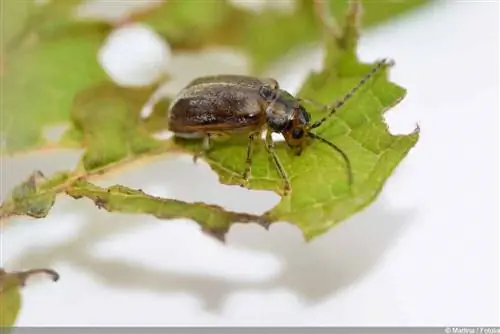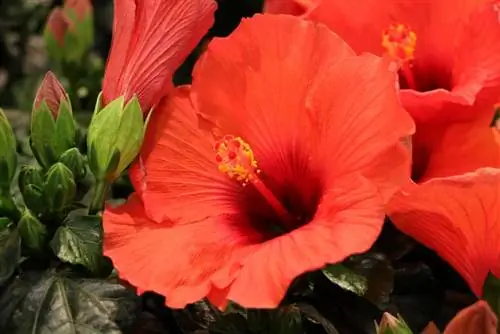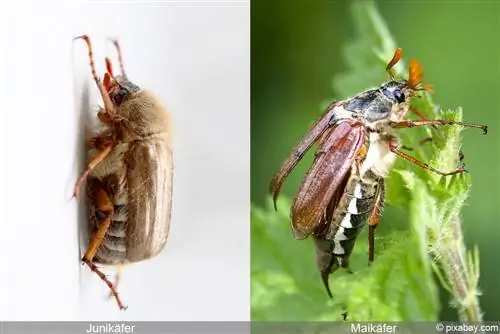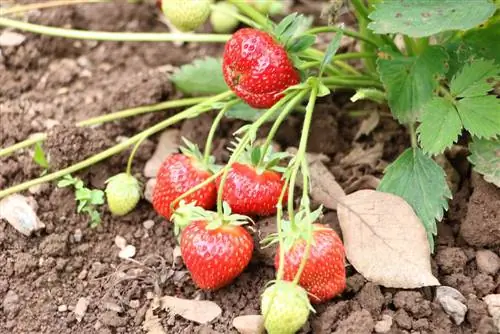- Author admin [email protected].
- Public 2023-12-17 03:39.
- Last modified 2025-01-24 12:45.
They persist in the ground for years, completely unnoticed by the gardener. Suddenly they come to the surface en masse. It quickly becomes clear that these little animals are a nuisance. At a breathtaking pace, they eat young trees bare, eat flowers and don't stop at the lawn. May beetles and June beetles are close relatives that share some similarities. But there are also differences.
The scarab beetle family
The scarab beetle family is one of the largest families of insects. It includes more than 20,000 species of beetles. The beetles owe their name to the appearance of their fillers. These consist of many small leaves at their ends that spread apart like a fan. One of the best-known members of this family are the pretty May beetles, which fly in the sunny month of May. The June beetles also come from the same family and are also native to this country. As their name suggests, they start their flight a month later than the cockchafers. And as is typical for relatives, there are some similarities, but also differences.
Profile: Cockchafer
- lives mainly in deciduous forests
- six legs, like all insects
- two pairs of wings
- thin, translucent skin wings serve as propellers
- red-brown, thick cover wings as wings
- Underside and pronotum are black
- black and white zigzag pattern on the sides
- 2, 5 to 3 cm tall
- Weight 0.4 to 0.9 g
- Lifespan as a larva: 3-4 years
- Lifespan as a beetle: max. 2 months
- feeds on roots and leaves
- diurnal
- Birds, hedgehogs, martens and wild boars are natural enemies
- Melolontha is its scientific name
- Includes three subspecies
- Field cockchafers and forest cockchafers are native to this country
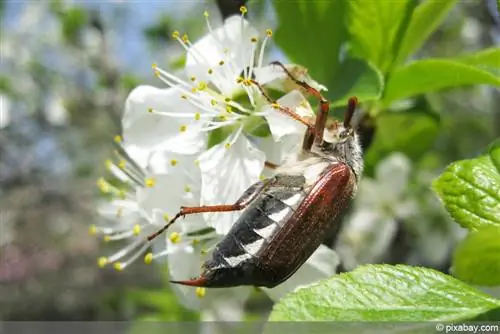
Profile: June beetle
- also called ribbed curlew beetle and summer beetle
- Latin name is 'Amphimallon solstitiale'
- 1.3 to 1.8 cm tall
- Lifespan approx. 6 weeks
- light brown chitin shell
- Body is slightly hairy
- feeds on leaves and flowers
- twilight and nocturnal
- hiding during the day
- lives in gardens, pastures and forests
- flies on June nights
- has bat, mole and shrew as enemies
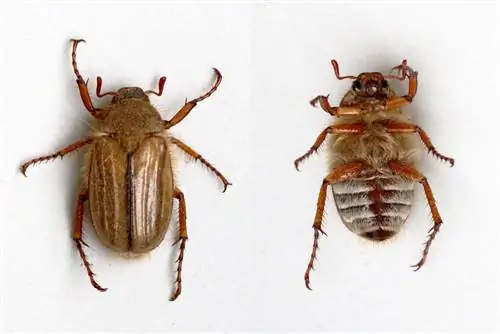
Which beetle is the pest in the garden?
For most gardeners, the June beetle is by far the biggest pest in the garden because it spreads in droves from June onwards. It eats lots of leaves and flowers until autumn. He also attacks the lawn. Cockchafers eat entire bare trees in May, which then recover and sprout again in June and July. At first glance, the June beetle is actually the bigger pest. But before the beetle becomes a beetle, it remains in the larval stage for several years. These are called grubs by beetles. And the grubs of the May beetles are in no way inferior to the grubs of the June beetles in terms of their voracity. Therefore, both species must be controlled in the garden if necessary.
Note:
The June beetle feels comfortable in high temperatures. A large number of June beetles can therefore be expected in particularly hot summers.
Grubs, the larvae of beetles
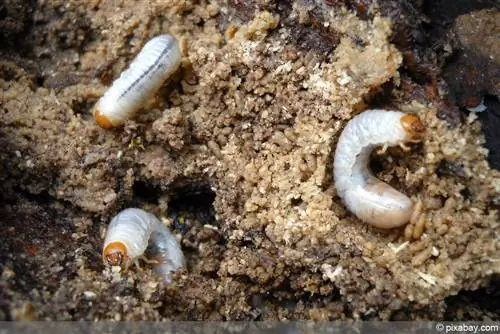
Both species of beetles, cockchafers and June beetles, lay eggs in the soil in order to continue to reproduce. The male beetles die after mating and the females eat their way through the garden to collect enough energy to lay their eggs. About two weeks after mating, they lay their eggs in a deeply dug hole in the ground. The female June beetles like to lay their eggs in the grass soil. After about six weeks, these eggs hatch into larvae called grubs. The life of these larvae takes place in the soil. Depending on the species of beetle, the lifespan of the grubs varies. June beetle larvae remain in the soil for about two years. May beetle larvae can remain in the soil for longer; their larval period usually lasts three to four years.
Grubs harm our plants
Grubs live in the ground and are therefore largely unnoticed by garden owners. If they find a moist environment, they have ideal conditions to cause major damage to the plants undisturbed underground.
- Grubs feed on plant remains and roots
- June beetle grubs love lawns
- Lawn is riddled with yellow and dry spots
- sometimes lawns die completely
- young and weak trees can die in plagues
- June beetle larvae also attack rose bushes
Fighting grubs effectively
The beetle larvae hatch from eggs that are deep in the ground. After hatching, the grubs also remain in the ground because they are sensitive to UV radiation. On the surface of the earth, where UV radiation is an integral part of sunlight, they would be exposed to it unprotected. This fact provides a successful combat approach.
- it doesn't matter whether larvae of May beetles and June beetles
- Larvae don't like dry soil
- Allow the soil to dry out in phases in spring and summer
- Milling soil
- Larvae come to the surface and die from UV rays
- Dig soil with zinc-containing cultivator
- Attracting beetles and larvae with scents
- parasitic fungi can protect lawn soil
Do beetles need to be controlled?
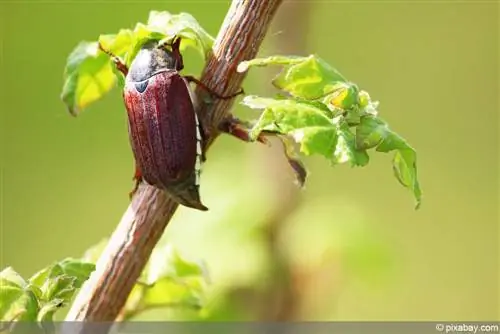
When the beetles start flying again in May and June, some green leaves will certainly fall victim to them. But the damage that an “average” number of beetles can cause is limited. In addition, he althy plants recover from leaf loss and sprout again quickly. There is no need to fight these beetles much as long as their numbers are not high. Chemical agents are not recommended as control agents anyway. Both beetles and their larvae are everywhere in the garden, which would have to be treated comprehensively with chemicals. The result is soil that is contaminated for years and is just as damaging to plants as it is to beetles and their larvae.
Natural predators of beetles and larvae
May and June beetles have natural predators. These are the gardener's best allies in the fight against beetles and are also a completely natural control agent. If the two types of beetles do not show strong growth, these natural enemies are completely sufficient. No further countermeasures are then necessary. The natural predators include:
- Hedgehog
- Bats
- moles
- Cats
- Birds
- Shrews
Promoting natural predators
Natural predators of beetles and grubs can be found in every garden. Targeted attracting measures can help to increase their numbers and attract more animals to the garden. These are crowned with success when the animals find optimal living conditions in the garden.
- Provide nesting opportunities for birds
- Hang up boxes for bats
- Attracting cats with cat food and water bowls
Tip:
Especially in small gardens it is necessary to specifically attract predators, as they are unlikely to be found here.
Regular beetle plagues
Beetles develop in cycles lasting several years. In some years there are very few beetles flying around, while in other years the number can be significantly higher. If the living conditions in the soil are optimal, many beetle larvae survive and thrive. Years later, when the larvae develop into beetles, beetle infestations often occur. The beetles then eat entire forest areas bare. However, he althy trees can recover from this infestation. The eggs they lay during this time and the grubs that hatch from them pose a far greater danger to the trees. They feed on their roots. The root loss can be so great that weak and young trees do not survive this damage.
Protective measures against beetle plagues
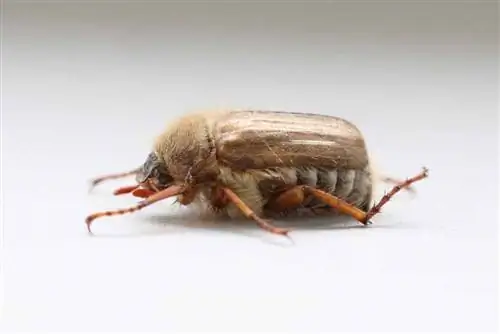
There can always be real beetle plagues. Decades pass between individual plagues, but when the plague arrives, the damage is enormous. Natural predators can do little against this mass of beetles, and other control measures do not have the desired effect. The garden is open to the public and beetles are always coming. Chemical control agents are harmful to people and nature and are therefore not recommended. In order to keep the damage caused by the beetle plague to a minimum, the plants and lawn must be protected immediately.
- Cover plants
- Keep the floor dry as much as possible
- Water plants specifically and close to the roots
- Cover lawns in the evening as June beetles are nocturnal
Tip:
Since the beetles, especially the June beetles, are very small, you should use close-meshed nets or tarpaulins to cover them.
These measures will not destroy the beetles, but will take away their habitat. They cannot fly under the nets and damage the plants. They are also prevented from mating and laying eggs, which keeps the number of beetles low in the following years.
Fighting beetles with nematodes
If the beetles appear in large numbers and your natural predators are no longer sufficient to combat them, you can also use nematodes. The control is carried out preventively by destroying the larvae before they can develop into beetles.
- biological control agent
- Nematodes, attack and kill grubs
- only use if the infestation is large
- limited shelf life, use immediately
- Use powder according to instructions for use
Tip:
Nematode preparations are available in garden centers, hardware stores and numerous online shops.


